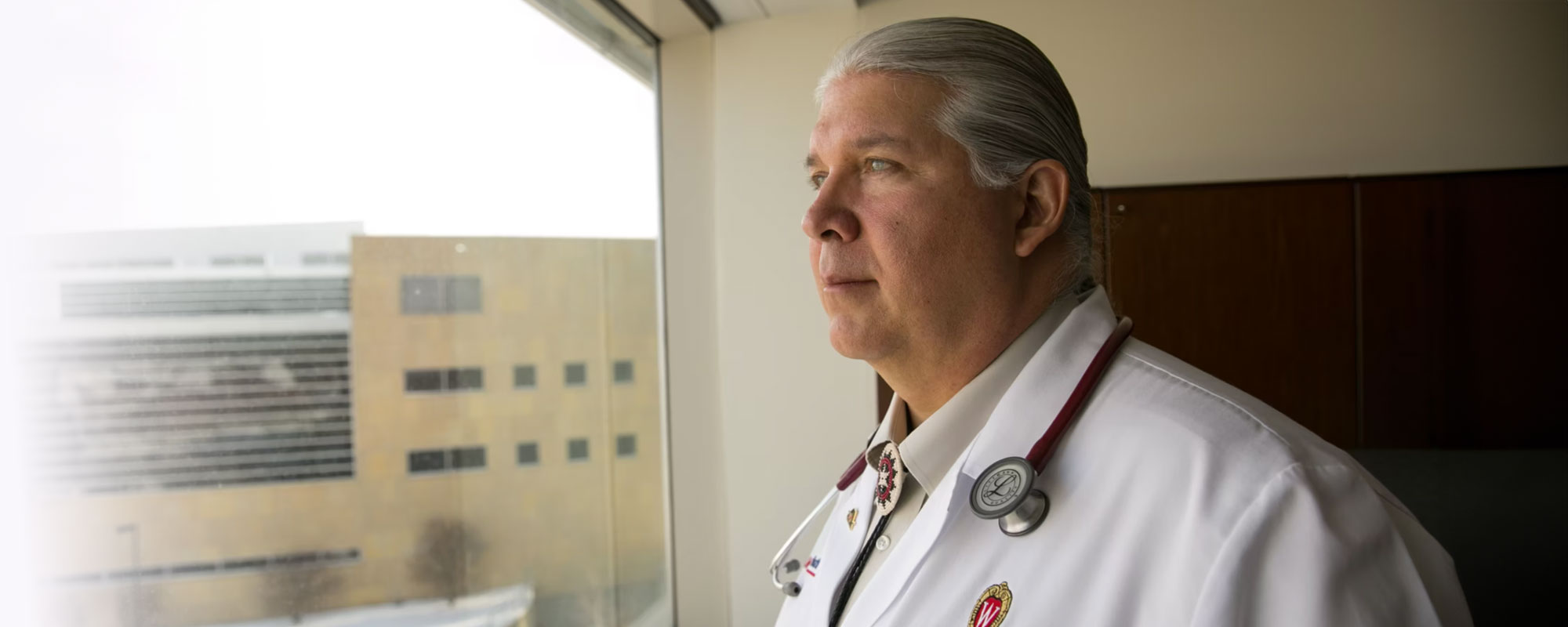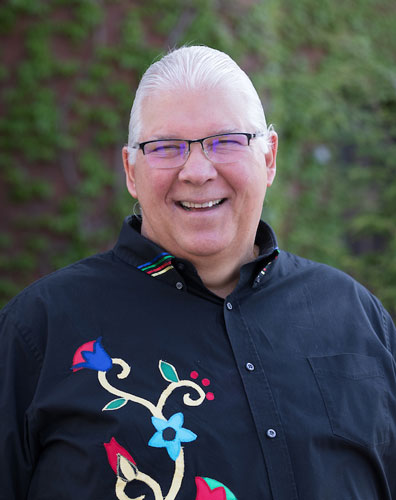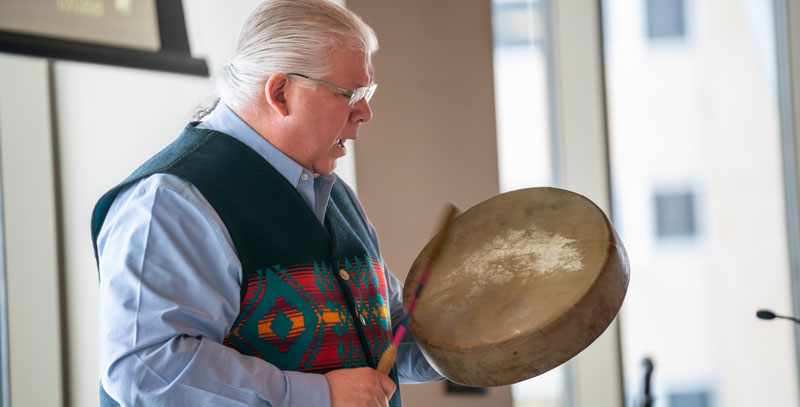Steadfast commitment to Native health

Dr. Bret Benally Thompson was working as a police officer in Texas when he had a “waking vision,” as he describes it, that directed him to pursue his dream of becoming a doctor.
Now a palliative care physician, an associate professor in the Department of Medicine, and the director of Indigenous health and cultural guidance for the Native American Center for Health Professions (NACHP), Benally Thompson has changed countless lives through exceptional patient care, tireless mentoring of Native students, and efforts to improve health in Native communities. In August, Benally Thompson was named Physician of the Year by the Association of American Indian Physicians. The award recognizes his “exemplary leadership and innovation in the field, significantly improving health outcomes and advocating for the well-being of Indigenous communities.”

Congratulations! How does it feel to be named Physician of the Year?
I am humbled and honored. This award is given by people I have looked up to since before medical school as some of the real giants, or forward thinkers, in American Indian health and health policy. The Association of American Indian Physicians is working hard to decrease the huge disparities that we deal with as Native people.
You have described your journey as a “winding path.” Where did it begin?
It began in northern Minnesota. Like a lot of Native people in this country, I grew up in a mixed family: Swedish on my mom’s side and mixed Ojibwe and French on my dad’s side. I spent a lot of time with my dad’s relatives on the Red Lake Reservation.
Describe how your White Earth Ojibwe heritage shaped your early years.
I was a kid in an era when it wasn’t good to be Native. My great grandmother was taken away to boarding school and that still ripples through the generations in my family. But I had wonderful experiences with my family on the reservation. I didn’t live there, but I started learning about our culture and our spirituality at a young age — from my uncles and others. At that time, it was still illegal in the U.S. for us to practice our spirituality. It wasn’t until 1978 that the Native American Freedom of Religion Act allowed some of those things to come back up from underground.
When did you first become interested in medicine?
As a kid, I had a plastic doll, or model, with a skin of clear plastic and organs inside. I would take that apart and study it. It was kind of an advanced toy [laughs]. I was always interested in science and in the human body. And one of my great grandparents and a great-great grandparent were healers, I was told.
You didn’t pursue medical school right away. What careers came first?
I tried being a cowboy, but making $175– $250 a month made me realize that I needed to go home and go back to college, which I did — and I failed miserably at that the first time around. I joined the National Guard to pay for college and served as a military policeman in the Army, as well as an active-duty infantry officer. I then did civilian police work for ten years. I really liked being a cop. It taught me a lot about other parts of our society and people who are less advantaged, including us Native people. I was also an emergency medical technician (EMT). I have always gravitated towards service jobs.
What lessons or skills did you bring from those roles into medicine?
Police work taught me how to talk to anybody and gave me insights and experiences into how life can change in an instant, for the worse. Just seeing how horrible life can be, and trying to help people through that — both as a cop and as an EMT — helps me be a good palliative care physician.
When did the path finally turn towards medical school?
One day when I was driving my patrol car outside of Austin, Texas, down a beautiful road in the hill country, I had this waking vision. I didn’t see anything, but I heard a clear voice saying, “This is not what you were meant to do. You were meant to be a healer, a physician for your people.” I was 28 years old. It meant I had to go back to school for all my premedical requirements, and by the time I started on that, I was 33. I became discouraged at one point, but a mentor from the AISES council of elders [the American Indian Science and Engineering Society is a 47-year-old national nonprofit that mentors and advances Indigenous people in science, medicine and technology fields] told me that I couldn’t quit, that our people needed me. I was 40 when I started medical school at the University of Minnesota Duluth.
How did you decide on palliative care as a specialty?
I had never heard of palliative care until I was doing my residency in Anchorage, Alaska at Providence Alaska Medical Center. In my third year I had the privilege of doing a rotation with a newly formed palliative care team there. I became Alaska’s first Palliative Care and Hospice Medicine fellow. Palliative care physicians see people with very serious illnesses, ones they are very likely to die from somewhere in the future. As part of our Hospice and Palliative Medicine fellowship here at UW, we teach compassion. That’s not often taught in medical school, but it should be. I think it is imperative for any physician, and it is a very teachable skill.
What led you to UW–Madison?
When I finished my residency, I went to work for the Indian Health Service in Red Lake, Minnesota. It was one of the hardest jobs I ever had, working within the federal system and the tribal system. Dr. Erik Brodt, a former mentee of mine, recruited me to UW–Madison. Erik had benefitted, as I had, from the Center of American Indian Minority Health at University of Minnesota Duluth. He wanted to start a similar organization to support Native health professions students at UW–Madison.

Describe how your role with NACHP evolved.
As Erik and others began to build the program, I gave support and offered ideas. Once it was launched in 2012 I stayed involved as a cultural advisor for students. Then Danielle Yancey, director of NACHP, asked me in 2018 if I would be the principal investigator for our Indians into Medicine grant, which we have just been awarded again, for the third time.
Why is NACHP’s mission so critically important?
Studies show that Native health professionals are 55% more likely to go back and work in a Native community than a non-Native person. Because of the historical trauma that Native people endured and continue to be affected by, there’s a certain amount of trust that comes with being seen by a Native provider. It’s not that non-Native providers don’t do a good job, it’s just that nobody takes care of a Native person like a Native provider.
I also know what the disparities are in our communities, for health care. Those things continue to motivate me in this work that I do for NACHP, and regionally and nationally, including for AISES.
What accomplishments are you most proud of?
Personally, I am proud of raising two amazing human beings, my girls, and being part of a strong extended family. Professionally, I’m most proud of the work that I do to support and encourage students to pursue, and be successful in, their education. I have had people support and help me all along the way. I expend a lot of intentional effort to do the same thing for other people that my guides did for me. I am also proud of my tireless effort to improve the health of our people, both medically and spiritually. I do my best to support our spiritual way of life. Native spirituality runs through every interaction I have with patients, and with any human being. It’s really what has made my life truly beautiful.
Banner image of Dr. Bret Benally Thompson from We are Healers video, produced by Finn Ryan with director of photography Lukas Korver.